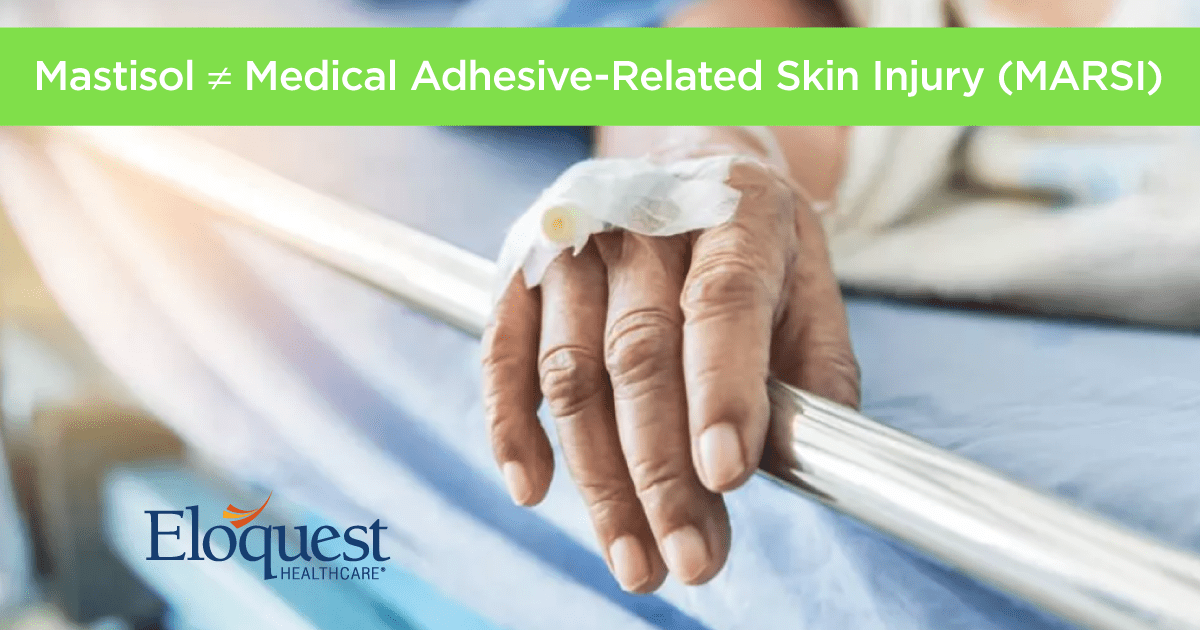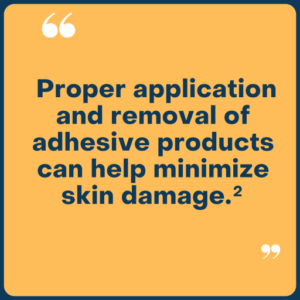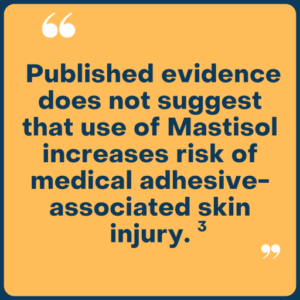
The Importance of Skin Integrity
Maintaining skin integrity is an important part of infection prevention throughout patient care. Skin is the body’s first line of defense, acting as a barrier to prevent harmful bacteria from entering the body. When this barrier is disrupted, pathogens can enter through the site of injury and cause infections.1
Skin injuries can also result in inflammation, increased wound size, and delayed healing.2
Adhesive Products: A Critical Part of Vascular Access
Medical adhesive products are a critical part of healthcare. They facilitate better securement of dressings and medical devices across virtually every medical specialty, including vascular access.2,3 With 70%-90% of acute care patients in the US requiring IV access, proper vascular access device securement is essential.4
Medical adhesives help to 2:
- Provide securement for critical and noncritical devices and products
- Facilitate skin protection and healing
- Allow for noninvasive monitoring
However, improper application and/or removal of adhesive products can 2:
- Compromise skin integrity
- Increase wound size and delay healing
- Cause pain and infection risk
- Increase healthcare costs
- Result in medical adhesive-related skin injury (MARSI)
Medical Adhesive-Related Skin Injury (MARSI): Prevalent, Yet Preventable
MARSI is a form of skin injury that can arise from use of adhesive products during patient care. It is a prevalent complication that has negative effects on patient safety and recovery.2 One two-week survey of 419 vascular access patients reported a skin injury rate of up to 29.89%.5
While use of adhesive products can contribute to MARSI development, the enhanced securement they offer results in fewer dressing changes. This can help mediate skin injury risk as repeated taping or dressing changes are one of the preventable causes of MARSI.

Additionally, using proper application and removal techniques is key to minimizing skin damage.2
It is also necessary to consider possible adverse consequences of adhesive failure when securing critical medical devices. Vascular access devices are classified as critical since there is significant risk to the patient if the devices dislodge or function improperly.2 As such, proper securement is essential to patient safety.
Mastisol ≠ MARSI

As securement of critical devices is ‘critical’, considering the use of gum mastic liquid adhesive to enhance dressing adherence is recommended by evidence-based guidelines.6 Some may be concerned that use of gum mastic liquid adhesives such as Mastisol® may exacerbate risk of potential skin injuries. However, the results of a study conducted by DeVries, et al. do not suggest that MARSI risk increases with use of Mastisol. Over an 18-month post-implementation period of new protocol including a securement dressing and Mastisol Liquid Adhesive,
approximately 30,000 dressing sites were assessed. 96% of dressings were fully intact without reinforcement at the time of assessment. Moreover, there were no reported increase in MARSI related to the updated protocol. Skin condition was documented through direct observation during rounds, WOC nurse consults, and review of incident reports.3 To learn more, access the full study here.
Eloquest Healthcare is committed to providing solutions that can help improve patient outcomes while reducing unnecessary costs. We can partner with your institution to facilitate a Vascular Access Device Site Assessment to determine the state of vascular access device sites & dressing securement for patients in your facility, while providing you and your team with information on your facility’s infection risk, nurse efficiency, and potential product waste. Click here to request a Vascular Access Device Site Assessment today!

References:
- Coates M, Blanchard S, MacLeod AS. Innate antimicrobial immunity in the skin: A protective barrier against bacteria, viruses, and fungi. PLoS Pathog. 2018 Dec 6;14(12):e1007353. doi: 10.1371/journal.ppat.1007353. PMID: 30522130; PMCID: PMC6283644. https://www.ncbi.nlm.nih.gov/pmc/articles/PMC6283644/#:~:text=Innate%20immunity%20is%20an%20essential,to%20the%20site%20of%20injury.
- McNichol L, Lund C, Rosen T, Gray M. Medical adhesives and patient safety: state of the science: consensus statements for the assessment, prevention, and treatment of adhesive-related skin injuries. Orthop Nurs. 2013 Sep-Oct;32(5):267-81. doi: 10.1097/NOR.0b013e3182a39caf. PMID: 24022422.
- DeVries M, Sarbenoff J, Scott N, Wickert M, Hayes LM. Improving Vascular Access Dressing Integrity in the Acute Care Setting: A Quality Improvement Project. J Wound Ostomy Continence Nurs. 2021 Sep-Oct 01;48(5):383-388. doi: 10.1097/WON.0000000000000787. PMID: 34198309; PMCID: PMC8415728. https://pubmed.ncbi.nlm.nih.gov/34198309/.
- Moreau, N. Shifting the Standard of Care in IV Dislodgement Prevention, Infection Control Today. 2019 May 2019 . https://www.infectioncontroltoday.com/view/shifting-standard-care-iv-dislodgement-prevention
- Zhao H, He Y, Huang H, Ling Y, Zhou X, Wei Q, Lei Y, Ying Y. Prevalence of medical adhesive-related skin injury at peripherally inserted central catheter insertion site in oncology patients. J Vasc Access. 2018 Jan;19(1):23-27. doi: 10.5301/jva.5000805. PMID: 29148003. https://pubmed.ncbi.nlm.nih.gov/29148003/.
- Gorski, LA, Hadaway, L, Hagle, ME, et al. Infusion Therapy Standards of Practice. 8TH J Infus Nurs. Revised 2021.







